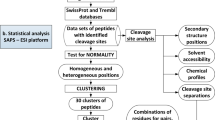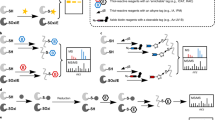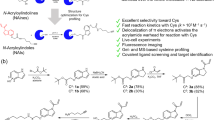Abstract
Proteases are one of the largest and best-characterized families of enzymes in the human proteome. Unfortunately, the understanding of protease function in the context of complex proteolytic cascades remains in its infancy. One major reason for this gap in understanding is the lack of technologies that allow direct assessment of protease activity. We report here an optimized solid-phase synthesis protocol that allows rapid generation of activity-based probes (ABPs) targeting a range of cysteine protease families. These reagents selectively form covalent bonds with the active-site thiol of a cysteine protease, allowing direct biochemical profiling of protease activities in complex proteomes. We present a number of probes containing either a single amino acid or an extended peptide sequence that target caspases, legumains, gingipains and cathepsins. Biochemical studies using these reagents highlight their overall utility and provide insight into the biochemical functions of members of these protease families.
This is a preview of subscription content, access via your institution
Access options
Subscribe to this journal
Receive 12 print issues and online access
$259.00 per year
only $21.58 per issue
Buy this article
- Purchase on Springer Link
- Instant access to full article PDF
Prices may be subject to local taxes which are calculated during checkout




Similar content being viewed by others
References
Speers, A.E. & Cravatt, B.F. Chemical strategies for activity-based proteomics. ChemBioChem 5, 41–47 (2004).
Berger, A.B., Vitorino, P.M. & Bogyo, M. Activity-based protein profiling: applications to biomarker discovery, in vivo imaging and drug discovery. Am. J. Pharmacogenomics 4, 371–381 (2004).
Jeffery, D.A. & Bogyo, M. Chemical proteomics and its application to drug discovery. Curr. Opin. Biotechnol. 14, 87–95 (2003).
Thornberry, N.A. et al. A combinatorial approach defines specificities of members of the caspase family and granzyme B. Functional relationships established for key mediators of apoptosis. J. Biol. Chem. 272, 17907–17911 (1997).
Stennicke, H.R., Renatus, M., Meldal, M. & Salvesen, G.S. Internally quenched fluorescent peptide substrates disclose the subsite preferences of human caspases 1, 3, 6, 7 and 8. Biochem. J. 350, 563–568 (2000).
Loak, K. et al. Novel cell-permeable acyloxymethylketone inhibitors of asparaginyl endopeptidase. Biol. Chem. 384, 1239–1246 (2003).
Niestroj, A.J. et al. Inhibition of mammalian legumain by Michael acceptors and AzaAsn-halomethylketones. Biol. Chem. 383, 1205–1214 (2002).
Asgian, J.L. et al. Aza-peptide epoxides: a new class of inhibitors selective for clan CD cysteine proteases. J. Med. Chem. 45, 4958–4960 (2002).
Powers, J.C., Asgian, J.L., Ekici, O.D. & James, K.E. Irreversible inhibitors of serine, cysteine, and threonine proteases. Chem. Rev. 102, 4639–4750 (2002).
Thornberry, N.A. et al. Inactivation of interleukin-1β converting enzyme by peptide (acyloxy)methyl ketones. Biochemistry 33, 3934–3940 (1994).
Uhlmann, F., Wernic, D., Poupart, M.A., Koonin, E.V. & Nasmyth, K. Cleavage of cohesin by the CD clan protease separin triggers anaphase in yeast. Cell 103, 375–386 (2000).
Lee, A., Huang, L. & Ellman, J.A. General solid-phase method for the preparation of mechanism-based cysteine protease inhibitors. J. Am. Chem. Soc. 121, 9907–9914 (1999).
Wood, W.J., Huang, L. & Ellman, J.A. Synthesis of a diverse library of mechanism-based cysteine protease inhibitors. J. Comb. Chem. 5, 869–880 (2003).
Chen, J.M., Rawlings, N.D., Stevens, R.A. & Barrett, A.J. Identification of the active site of legumain links it to caspases, clostripain and gingipains in a new clan of cysteine endopeptidases. FEBS Lett. 441, 361–365 (1998).
Fox, T., Mason, P., Storer, A.C. & Mort, J.S. Modification of S1 subsite specificity in the cysteine protease cathepsin B. Protein Eng. 8, 53–57 (1995).
Manoury, B. et al. An asparaginyl endopeptidase processes a microbial antigen for class II MHC presentation. Nature 396, 695–699 (1998).
Chen, J.M., Fortunato, M. & Barrett, A.J. Activation of human prolegumain by cleavage at a C-terminal asparagine residue. Biochem. J. 352, 327–334 (2000).
Li, D.N., Matthews, S.P., Antoniou, A.N., Mazzeo, D. & Watts, C. Multistep autoactivation of asparaginyl endopeptidase in vitro and in vivo. J. Biol. Chem. 278, 38980–38990 (2003).
Halfon, S., Patel, S., Vega, F., Zurawski, S. & Zurawski, G. Autocatalytic activation of human legumain at aspartic acid residues. FEBS Lett. 438, 114–118 (1998).
Boatright, K.M. & Salvesen, G.S. Mechanisms of caspase activation. Curr. Opin. Cell Biol. 15, 725–731 (2003).
Li, P. et al. Cytochrome c and dATP-dependent formation of Apaf-1/caspase-9 complex initiates an apoptotic protease cascade. Cell 91, 479–489 (1997).
Meergans, T., Hildebrandt, A.K., Horak, D., Haenisch, C. & Wendel, A. The short prodomain influences caspase-3 activation in HeLa cells. Biochem. J. 349, 135–140 (2000).
Denault, J.B. & Salvesen, G.S. Human caspase-7 activity and regulation by its N-terminal peptide. J. Biol. Chem. 278, 34042–34050 (2003).
Turk, B., Turk, V. & Turk, D. Structural and functional aspects of papain-like cysteine proteinases and their protein inhibitors. Biol. Chem. 378, 141–150 (1997).
Bogyo, M., Verhelst, S., Bellingard-Dubouchaud, V., Toba, S. & Greenbaum, D. Selective targeting of lysosomal cysteine proteases with radiolabeled electrophilic substrate analogs. Chem. Biol. 7, 27–38 (2000).
Yamamoto, A. et al. Crystallization and preliminary X-ray study of the cathepsin B complexed with CA074, a selective inhibitor. J. Mol. Biol. 227, 942–944 (1992).
Stennicke, H.R. & Salvesen, G.S. Caspases: preparation and characterization. Methods 17, 313–319 (1999).
Stennicke, H.R. et al. Pro-caspase-3 is a major physiologic target of caspase-8. J. Biol. Chem. 273, 27084–27090 (1998).
Acknowledgements
We thank C. Watts (University of Dundee) for legumain antibodies, C. Peters and T. Reinheckel (Albert-Ludwigs-Universität Freiburg) for legumain-knockout mouse tissues, H. Chapman and J. Lee (University of California, San Francisco) for recombinant mouse legumain, V. Turk and B. Turk (J. Stefan Institute) for recombinant human cathepsin L, J. Potempa (University of Georgia) for P. gingivalis cell extracts and purified gingipains, and T. Burster (Stanford University) for cell lines. We thank A. Price and S. Snipas for technical assistance, L. Carpino (University of Massachusetts) for critical advice on the removal of the Fmoc protecting group and J. Ellman, A. Lee, L. Huang and W. Wood for helpful discussions. This work was supported by a Turman Fellowship at Stanford University (to M.B.), a National Institutes of Health National Technology Center for Networks and Pathways grant U54 RR020843 (to M.B. and G.S.S.) and a Department of Defense Breast Cancer Center of Excellence grant DAMD-17-02-0693 (to B. Sloane—M.B. subcontract). A.B. was funded by a National Human Genome Research Institute training grant 5T32 HG00044.
Author information
Authors and Affiliations
Corresponding author
Ethics declarations
Competing interests
The authors declare no competing financial interests.
Supplementary information
Supplementary Fig. 1
Optimization of Fmoc deprotection during solid phase synthesis of peptide AOMK probes. (PDF 776 kb)
Supplementary Fig. 2
Labeling of protease targets using simple P1 AOMK probes in crude proteomes. (PDF 3622 kb)
Rights and permissions
About this article
Cite this article
Kato, D., Boatright, K., Berger, A. et al. Activity-based probes that target diverse cysteine protease families. Nat Chem Biol 1, 33–38 (2005). https://doi.org/10.1038/nchembio707
Received:
Accepted:
Published:
Issue Date:
DOI: https://doi.org/10.1038/nchembio707
This article is cited by
-
Fundamentals and developments in fluorescence-guided cancer surgery
Nature Reviews Clinical Oncology (2022)
-
A proteome-wide atlas of lysine-reactive chemistry
Nature Chemistry (2021)
-
Contribution of the plasma and lymph Degradome and Peptidome to the MHC Ligandome
Immunogenetics (2019)
-
Determination of extended substrate specificity of the MALT1 as a strategy for the design of potent substrates and activity-based probes
Scientific Reports (2018)
-
Global profiling of lysine reactivity and ligandability in the human proteome
Nature Chemistry (2017)



